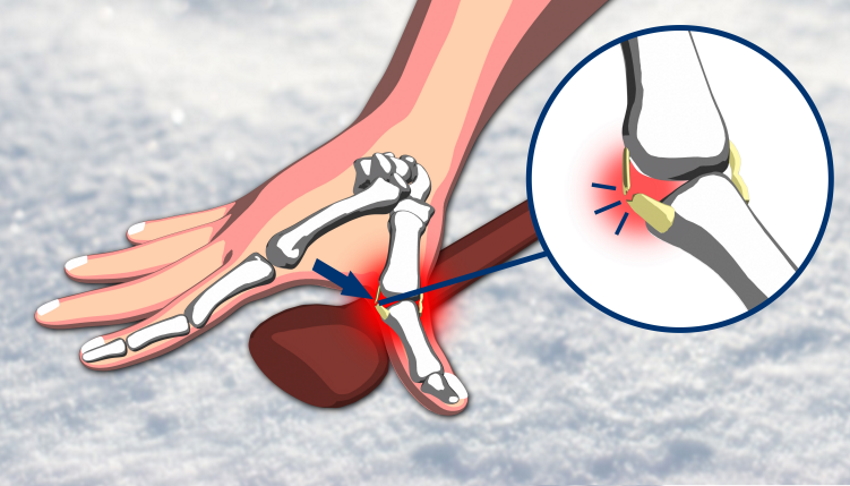Our thumbs are essential to providing the pincer movement that allows precision of hand movement. The collateral ligaments stabilise the thumb metacarpal joint. The ulnar collateral ligament on the inside of the thumb is prone to injury after a fall. Moreover, a stener lesion, also called skier’s thumb, is a complete tear of the ulnar collateral ligament. How do we recognise a stener lesion, and what do we do about it?
What is the ulnar collateral ligament?
The ulnar collateral ligament connects the bones of the base of the thumb. It provides stability to the joint, particularly when picking up objects with your thumb.
Causes of skier’s thumb or Stener lesion

Injury to the ulnar collateral ligament occurs when the ligament is stretched too far. Generally, damage to the ligament occurs after a fall, forcing the thumb away from the hand. We call this injury skier’s thumb. When a skier falls on their thumb with the hand still attached to the pole, the thumb is forced away from the hand. This fall stretches or tears the ulnar collateral ligament, depending on how the thumb moves.
If the ligament tears completely, it is prevented from reattaching to the bone through superficial tissue or muscle (called the adductor aponeurosis).
Stener lesion or Skier’s Thumb Symptoms
Usually, we injure the ulnar collateral ligament through a fall onto the thumb. Initially, people report pain and swelling directly at the site of the torn ligament. Once the swelling settles, people often say they have difficulty picking up or holding objects. Sometimes, people report instability or catching their thumb in the pockets of their pants.
How to diagnose a stener lesion
Generally, diagnosis is based on a history of a fall. Then, we perform a careful examination to confirm a torn ulnar collateral ligament and rule out other problems such as a fracture. Applying stress to the thumb demonstrates increased gaping compared to the normal side.
Stener lesion radiology
X-rays are helpful in ruling out a small piece of bone pulled from the metacarpal bone by the torn ligament. Then, we perform an ultrasound or MRI to confirm a diagnosis of a torn ligament. Overall, imaging is vital to demonstrate whether the ligament is partially or fully torn.
Treatment of Skier’s Thumb
Generally, Skier’s thumb treatment depends on the extent of the ligament injury.
For partial tears, we place people in a thumb splint or cast for 4-6 weeks. By immobilising the thumb in a cast, the damaged ligament scars up and heals.
If the ligament is fully torn, surgery is needed to reattach the ligament to the correct place. If the tear is acute, the surgeon repairs the ligament. However, if the tear is chronic, the reattachment is less likely. In this case, surgeons use a graft from another site to reconstruct the ligament. After surgery, we place the thumb in a cast for 4-6 weeks, followed by hand therapy. Generally, it takes 3-4 months before you can return to the sport.
Final word from Sportdoctorlondon about Stener lesion
We must think about an ulnar collateral ligament injury, or Skier’s thumb, after a fall onto the thumb. It is essential to confirm a diagnosis of a ligament tear early so we can start the correct treatment immediately.



Leave A Comment